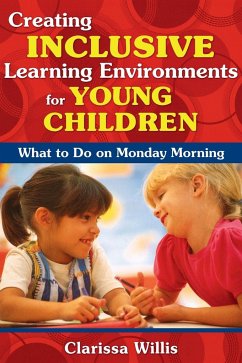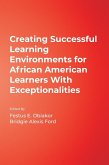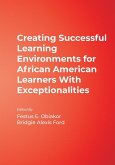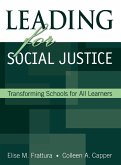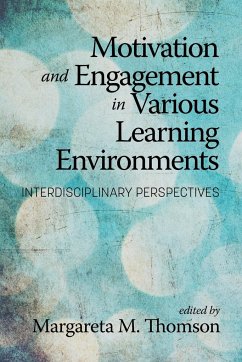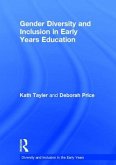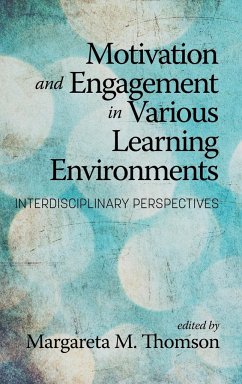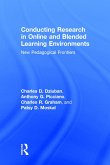Clarissa Willis
Creating Inclusive Learning Environments for Young Children
What to Do on Monday Morning
Clarissa Willis
Creating Inclusive Learning Environments for Young Children
What to Do on Monday Morning
- Gebundenes Buch
- Merkliste
- Auf die Merkliste
- Bewerten Bewerten
- Teilen
- Produkt teilen
- Produkterinnerung
- Produkterinnerung
This book provides information on common disabilities and practical strategies for creating inclusive environments and building student relationships.
Andere Kunden interessierten sich auch für
![Creating Successful Learning Environments for African American Learners With Exceptionalities Creating Successful Learning Environments for African American Learners With Exceptionalities]() Festus E. ObiakorCreating Successful Learning Environments for African American Learners With Exceptionalities95,99 €
Festus E. ObiakorCreating Successful Learning Environments for African American Learners With Exceptionalities95,99 €![Creating Successful Learning Environments for African American Learners With Exceptionalities Creating Successful Learning Environments for African American Learners With Exceptionalities]() Festus E ObiakorCreating Successful Learning Environments for African American Learners With Exceptionalities44,99 €
Festus E ObiakorCreating Successful Learning Environments for African American Learners With Exceptionalities44,99 €![Leading for Social Justice Leading for Social Justice]() Elise M. FratturaLeading for Social Justice97,99 €
Elise M. FratturaLeading for Social Justice97,99 €![Motivation and Engagement in Various Learning Environments Motivation and Engagement in Various Learning Environments]() Motivation and Engagement in Various Learning Environments62,99 €
Motivation and Engagement in Various Learning Environments62,99 €![Gender Diversity and Inclusion in Early Years Education Gender Diversity and Inclusion in Early Years Education]() Kath TaylerGender Diversity and Inclusion in Early Years Education178,99 €
Kath TaylerGender Diversity and Inclusion in Early Years Education178,99 €![Motivation and Engagement in Various Learning Environments Motivation and Engagement in Various Learning Environments]() Motivation and Engagement in Various Learning Environments108,99 €
Motivation and Engagement in Various Learning Environments108,99 €![Conducting Research in Online and Blended Learning Environments Conducting Research in Online and Blended Learning Environments]() Charles D. DziubanConducting Research in Online and Blended Learning Environments210,99 €
Charles D. DziubanConducting Research in Online and Blended Learning Environments210,99 €-
-
-
This book provides information on common disabilities and practical strategies for creating inclusive environments and building student relationships.
Hinweis: Dieser Artikel kann nur an eine deutsche Lieferadresse ausgeliefert werden.
Hinweis: Dieser Artikel kann nur an eine deutsche Lieferadresse ausgeliefert werden.
Produktdetails
- Produktdetails
- Verlag: Corwin
- Seitenzahl: 242
- Erscheinungstermin: 1. August 2008
- Englisch
- Abmessung: 260mm x 183mm x 18mm
- Gewicht: 658g
- ISBN-13: 9781412957182
- ISBN-10: 1412957184
- Artikelnr.: 23514923
- Herstellerkennzeichnung
- Books on Demand GmbH
- In de Tarpen 42
- 22848 Norderstedt
- info@bod.de
- 040 53433511
- Verlag: Corwin
- Seitenzahl: 242
- Erscheinungstermin: 1. August 2008
- Englisch
- Abmessung: 260mm x 183mm x 18mm
- Gewicht: 658g
- ISBN-13: 9781412957182
- ISBN-10: 1412957184
- Artikelnr.: 23514923
- Herstellerkennzeichnung
- Books on Demand GmbH
- In de Tarpen 42
- 22848 Norderstedt
- info@bod.de
- 040 53433511
Clarissa A. Willis is the associate director of the Center of Excellence at East Tennessee State University and an associate professor of special education in the Department of Human Development and Learning. She is the author of Teaching Young Children with Autism Spectrum Disorders and coauthor of Inclusive Literacy Lessons with Special Education Adaptations. Willis has over 30 years of experience working with children with special needs as a speech pathologist, early interventionist, teacher, and grant administrator. As a consultant, she has provided workshops and keynote addresses to schools and organizations across the country and abroad.
Acknowledgments About the Author Introduction Part I. Children With Special Needs in the Inclusive Classroom 1. Working With Children With Special Needs What Do I Need to Know to Work With Children With Special Needs? Setting the Stage for Inclusion Inclusion, Blending, and Reverse Mainstreaming Why Is Inclusion Important? What Is "Meaningful" Inclusion? How Do I Develop a Philosophy of Meaningful Inclusion? General Strategies for Working With Children With Special Needs How Do I Get the Child
s Family Involved? Resources for Families Working to "Enable" and "Empower" Families Terms Used in This Chapter Resources Used in This Chapter Suggested Reading The Research Says...Developmentally Appropriate Practices Must Apply to Everyone 2. Blending the World of Special Education With General Education Services Best Practices According to NAEYC and DEC Constructivism vs. Behaviorism: Blending Without Ignoring Best Practice Using Observation Skills to Guide Instruction Planning for an IEP Meeting The Teacher
s Rules of the Road Related Services The Role of the Special Education Teacher Working With Paraprofessionals and Instructional Assistants Terms Used in This Chapter Resources Used in This Chapter Suggested Reading The Research Says...What Early Childhood Practitioners Think About Inclusion Part II. Who Are the Children With Special Needs? 3. Children With Vision Impairments How Do Young Children Develop Vision? What Causes Visual Impairments in Young Children? How Are Vision Impairments Classified? What Resources Are Available to Help the Child Function in My Classroom? How Do Children With Vision Impairments Learn? Preparing the Early Childhood Environment Suggestions for Children With Low Vision Suggestions for Children Who Are Blind or Severely Vision Impaired Summary Terms Used in This Chapter Resources Used in This Chapter Suggested Reading The Research Says...Play Behaviors in Young Children Who Are Blind 4. Children With Hearing Loss Defining Hearing Loss What Determines the Degree of Hearing Loss? So, What About Hearing Aids? Cochlear Implant How Will Hearing Loss Affect Children in My Classroom? Social Isolation Effects of Hearing Loss on Speech (Oral Language) Reduced Academic Achievement Suggestions for the Classroom Terms Used in This Chapter Resources Used in This Chapter Suggested Reading The Research Says...Cochlear Implants Can Result in Better Prosody 5. Children With Cognitive Challenges Understanding the Challenges for Children With Cognitive Delays Characteristics of Children With Cognitive Challenges Educational Implications What Are Functional Skills and Why Are They Important? How Do I Teach Everyday Tasks (Functional Skills)? What Do I Do First, Before Teaching a New Skill? How Exactly Does This All Fit Together? Classroom Suggestions for Children With Cognitive Challenges Summary Terms Used in This Chapter Resources Used in This Chapter Suggested Reading The Research Says...Social Development Across Time 6. Children With Atypical Motor Development Causes of Atypical Motor Development Muscle Tone Cerebral Palsy Fine and Gross Motor Skills Positioning and Handling Adaptive Equipment Summary Terms Used in This Chapter Resources Used in This Chapter Suggested Reading The Research Says...Children With Motor Delays Are At-Risk for Social Isolation 7. Children With Communication Delays What Is Communication? Understanding the Child
s "Form" of Communication Function and Content of Communication The Nonverbal Child Cleft Lip and Palate Childhood Apraxia of Speech (CAS) Terms Used in This Chapter Resources Used in This Chapter Suggested Reading The Research Says...Communication Is More Than Just Imitation 8. Children With Emotional/Behavior Disorders What Are Challenging Behaviors? Young Children and Mental Health Anxiety Disorders Classroom Suggestions for Children with Anxiety Disorders Separation Anxiety Classroom Suggestions for Children With Separation Anxiety Post-Traumatic Stress Disorder (PTSD) Classroom Suggestions for Children With PTSD Oppositional Defiant Disorder (ODD) Classroom Suggestions for Children With ODD Attention Deficit/Hyperactivity Disorder (ADHD) Medication Issues Classroom Suggestions for Children With ADHD Summary Terms Used in This Chapter Resources Used in This Chapter Suggested Reading The Research Says...Risk Factors for Future Challenging Behaviors 9. Children With Autism Spectrum Disorder (ASD) What Is a Spectrum Disorder? What Is Autism? What Are the Five Types of Autism? Begin by Looking at the Child
s Behavior Communication Issues Developing Social Skills Summary Terms Used in This Chapter Resources Used in This Chapter Suggested Reading The Research Says...The Role of Attention and Intention in Learning New Words 10. Children With Sensory Integration Disorder What Exactly Is Sensory Integration? Sensory Integration Disorder What Can I Do to Make My Classroom Sensory "Friendly"? Materials for the "Sensory Friendly" Classroom Terms Used in This Chapter Resources Used in This Chapter Suggested Reading The Research Says...Trauma and Sensory Modulation Disorder 11. Children At Risk for School Failure Who Are Children At Risk? Children Living in Extreme Poverty Homelessness Family Factors Chronic Illness Future Learning Disability Classroom Suggestions for Children At Risk Terms Used in This Chapter Resources Used in This Chapter Suggested Reading The Research Says...Teen Mothers Living in Transitional Shelters Need Support Part III. Strategies for the Inclusive Classroom 12. Preparing the Children Before the First Day of School How Do I Prepare Children in a General Education Setting for a Child With Special Needs? What Kinds of Activities Teach Tolerance and Acceptance of Others? The Socially Competent Child Terms Used in this Chapter Suggested Reading 13. Preparing the Environment The Important Role of the Environment Maintaining a Balance Between Activities The Daily Schedule Large Group Time Small Group Time Individualized Instruction Free Choice Time Transitions Assistive Technology--Adapting Materials Summary Terms Used in This Chapter Resources Used in This Chapter Suggested Reading 14. The Curriculum What Role Does the Curriculum Play in Teaching Children With Special Needs? Is There a Special "Curriculum" for a Child With Special Needs? Curriculum Models Differentiated Instruction (DI) Response to Intervention (RTI) Recognition and Response Curriculum Modifications for Children With Special Needs Content Area Instruction Terms Used in This Chapter Resources Used in This Chapter Suggested Reading 15. Handling Challenging Behaviors What Is Challenging Behavior? What Kinds of Behaviors Can I Tolerate? What Is a Functional Assessment? Identification of Positive Behaviors Terms Used in This Chapter Resources Used in This Chapter Suggested Reading 16. Building Communication Understanding Communication Levels of Communication Development How Do You Set Appropriate Goals for Communication? What About Children Who Are Nonverbal? Low-Tech Methods of Communication How Do I Start Helping a Child With Special Needs Use Pictures to Communicate? What About Electronic Communication Devices? Picture Schedules Terms Used in This Chapter Resources Used in This Chapter Suggested Reading Appendix Children
s Books That Feature Dynamic Characters With Special Needs Resources for Special Needs Products Index
s Family Involved? Resources for Families Working to "Enable" and "Empower" Families Terms Used in This Chapter Resources Used in This Chapter Suggested Reading The Research Says...Developmentally Appropriate Practices Must Apply to Everyone 2. Blending the World of Special Education With General Education Services Best Practices According to NAEYC and DEC Constructivism vs. Behaviorism: Blending Without Ignoring Best Practice Using Observation Skills to Guide Instruction Planning for an IEP Meeting The Teacher
s Rules of the Road Related Services The Role of the Special Education Teacher Working With Paraprofessionals and Instructional Assistants Terms Used in This Chapter Resources Used in This Chapter Suggested Reading The Research Says...What Early Childhood Practitioners Think About Inclusion Part II. Who Are the Children With Special Needs? 3. Children With Vision Impairments How Do Young Children Develop Vision? What Causes Visual Impairments in Young Children? How Are Vision Impairments Classified? What Resources Are Available to Help the Child Function in My Classroom? How Do Children With Vision Impairments Learn? Preparing the Early Childhood Environment Suggestions for Children With Low Vision Suggestions for Children Who Are Blind or Severely Vision Impaired Summary Terms Used in This Chapter Resources Used in This Chapter Suggested Reading The Research Says...Play Behaviors in Young Children Who Are Blind 4. Children With Hearing Loss Defining Hearing Loss What Determines the Degree of Hearing Loss? So, What About Hearing Aids? Cochlear Implant How Will Hearing Loss Affect Children in My Classroom? Social Isolation Effects of Hearing Loss on Speech (Oral Language) Reduced Academic Achievement Suggestions for the Classroom Terms Used in This Chapter Resources Used in This Chapter Suggested Reading The Research Says...Cochlear Implants Can Result in Better Prosody 5. Children With Cognitive Challenges Understanding the Challenges for Children With Cognitive Delays Characteristics of Children With Cognitive Challenges Educational Implications What Are Functional Skills and Why Are They Important? How Do I Teach Everyday Tasks (Functional Skills)? What Do I Do First, Before Teaching a New Skill? How Exactly Does This All Fit Together? Classroom Suggestions for Children With Cognitive Challenges Summary Terms Used in This Chapter Resources Used in This Chapter Suggested Reading The Research Says...Social Development Across Time 6. Children With Atypical Motor Development Causes of Atypical Motor Development Muscle Tone Cerebral Palsy Fine and Gross Motor Skills Positioning and Handling Adaptive Equipment Summary Terms Used in This Chapter Resources Used in This Chapter Suggested Reading The Research Says...Children With Motor Delays Are At-Risk for Social Isolation 7. Children With Communication Delays What Is Communication? Understanding the Child
s "Form" of Communication Function and Content of Communication The Nonverbal Child Cleft Lip and Palate Childhood Apraxia of Speech (CAS) Terms Used in This Chapter Resources Used in This Chapter Suggested Reading The Research Says...Communication Is More Than Just Imitation 8. Children With Emotional/Behavior Disorders What Are Challenging Behaviors? Young Children and Mental Health Anxiety Disorders Classroom Suggestions for Children with Anxiety Disorders Separation Anxiety Classroom Suggestions for Children With Separation Anxiety Post-Traumatic Stress Disorder (PTSD) Classroom Suggestions for Children With PTSD Oppositional Defiant Disorder (ODD) Classroom Suggestions for Children With ODD Attention Deficit/Hyperactivity Disorder (ADHD) Medication Issues Classroom Suggestions for Children With ADHD Summary Terms Used in This Chapter Resources Used in This Chapter Suggested Reading The Research Says...Risk Factors for Future Challenging Behaviors 9. Children With Autism Spectrum Disorder (ASD) What Is a Spectrum Disorder? What Is Autism? What Are the Five Types of Autism? Begin by Looking at the Child
s Behavior Communication Issues Developing Social Skills Summary Terms Used in This Chapter Resources Used in This Chapter Suggested Reading The Research Says...The Role of Attention and Intention in Learning New Words 10. Children With Sensory Integration Disorder What Exactly Is Sensory Integration? Sensory Integration Disorder What Can I Do to Make My Classroom Sensory "Friendly"? Materials for the "Sensory Friendly" Classroom Terms Used in This Chapter Resources Used in This Chapter Suggested Reading The Research Says...Trauma and Sensory Modulation Disorder 11. Children At Risk for School Failure Who Are Children At Risk? Children Living in Extreme Poverty Homelessness Family Factors Chronic Illness Future Learning Disability Classroom Suggestions for Children At Risk Terms Used in This Chapter Resources Used in This Chapter Suggested Reading The Research Says...Teen Mothers Living in Transitional Shelters Need Support Part III. Strategies for the Inclusive Classroom 12. Preparing the Children Before the First Day of School How Do I Prepare Children in a General Education Setting for a Child With Special Needs? What Kinds of Activities Teach Tolerance and Acceptance of Others? The Socially Competent Child Terms Used in this Chapter Suggested Reading 13. Preparing the Environment The Important Role of the Environment Maintaining a Balance Between Activities The Daily Schedule Large Group Time Small Group Time Individualized Instruction Free Choice Time Transitions Assistive Technology--Adapting Materials Summary Terms Used in This Chapter Resources Used in This Chapter Suggested Reading 14. The Curriculum What Role Does the Curriculum Play in Teaching Children With Special Needs? Is There a Special "Curriculum" for a Child With Special Needs? Curriculum Models Differentiated Instruction (DI) Response to Intervention (RTI) Recognition and Response Curriculum Modifications for Children With Special Needs Content Area Instruction Terms Used in This Chapter Resources Used in This Chapter Suggested Reading 15. Handling Challenging Behaviors What Is Challenging Behavior? What Kinds of Behaviors Can I Tolerate? What Is a Functional Assessment? Identification of Positive Behaviors Terms Used in This Chapter Resources Used in This Chapter Suggested Reading 16. Building Communication Understanding Communication Levels of Communication Development How Do You Set Appropriate Goals for Communication? What About Children Who Are Nonverbal? Low-Tech Methods of Communication How Do I Start Helping a Child With Special Needs Use Pictures to Communicate? What About Electronic Communication Devices? Picture Schedules Terms Used in This Chapter Resources Used in This Chapter Suggested Reading Appendix Children
s Books That Feature Dynamic Characters With Special Needs Resources for Special Needs Products Index
Acknowledgments About the Author Introduction Part I. Children With Special Needs in the Inclusive Classroom 1. Working With Children With Special Needs What Do I Need to Know to Work With Children With Special Needs? Setting the Stage for Inclusion Inclusion, Blending, and Reverse Mainstreaming Why Is Inclusion Important? What Is "Meaningful" Inclusion? How Do I Develop a Philosophy of Meaningful Inclusion? General Strategies for Working With Children With Special Needs How Do I Get the Child
s Family Involved? Resources for Families Working to "Enable" and "Empower" Families Terms Used in This Chapter Resources Used in This Chapter Suggested Reading The Research Says...Developmentally Appropriate Practices Must Apply to Everyone 2. Blending the World of Special Education With General Education Services Best Practices According to NAEYC and DEC Constructivism vs. Behaviorism: Blending Without Ignoring Best Practice Using Observation Skills to Guide Instruction Planning for an IEP Meeting The Teacher
s Rules of the Road Related Services The Role of the Special Education Teacher Working With Paraprofessionals and Instructional Assistants Terms Used in This Chapter Resources Used in This Chapter Suggested Reading The Research Says...What Early Childhood Practitioners Think About Inclusion Part II. Who Are the Children With Special Needs? 3. Children With Vision Impairments How Do Young Children Develop Vision? What Causes Visual Impairments in Young Children? How Are Vision Impairments Classified? What Resources Are Available to Help the Child Function in My Classroom? How Do Children With Vision Impairments Learn? Preparing the Early Childhood Environment Suggestions for Children With Low Vision Suggestions for Children Who Are Blind or Severely Vision Impaired Summary Terms Used in This Chapter Resources Used in This Chapter Suggested Reading The Research Says...Play Behaviors in Young Children Who Are Blind 4. Children With Hearing Loss Defining Hearing Loss What Determines the Degree of Hearing Loss? So, What About Hearing Aids? Cochlear Implant How Will Hearing Loss Affect Children in My Classroom? Social Isolation Effects of Hearing Loss on Speech (Oral Language) Reduced Academic Achievement Suggestions for the Classroom Terms Used in This Chapter Resources Used in This Chapter Suggested Reading The Research Says...Cochlear Implants Can Result in Better Prosody 5. Children With Cognitive Challenges Understanding the Challenges for Children With Cognitive Delays Characteristics of Children With Cognitive Challenges Educational Implications What Are Functional Skills and Why Are They Important? How Do I Teach Everyday Tasks (Functional Skills)? What Do I Do First, Before Teaching a New Skill? How Exactly Does This All Fit Together? Classroom Suggestions for Children With Cognitive Challenges Summary Terms Used in This Chapter Resources Used in This Chapter Suggested Reading The Research Says...Social Development Across Time 6. Children With Atypical Motor Development Causes of Atypical Motor Development Muscle Tone Cerebral Palsy Fine and Gross Motor Skills Positioning and Handling Adaptive Equipment Summary Terms Used in This Chapter Resources Used in This Chapter Suggested Reading The Research Says...Children With Motor Delays Are At-Risk for Social Isolation 7. Children With Communication Delays What Is Communication? Understanding the Child
s "Form" of Communication Function and Content of Communication The Nonverbal Child Cleft Lip and Palate Childhood Apraxia of Speech (CAS) Terms Used in This Chapter Resources Used in This Chapter Suggested Reading The Research Says...Communication Is More Than Just Imitation 8. Children With Emotional/Behavior Disorders What Are Challenging Behaviors? Young Children and Mental Health Anxiety Disorders Classroom Suggestions for Children with Anxiety Disorders Separation Anxiety Classroom Suggestions for Children With Separation Anxiety Post-Traumatic Stress Disorder (PTSD) Classroom Suggestions for Children With PTSD Oppositional Defiant Disorder (ODD) Classroom Suggestions for Children With ODD Attention Deficit/Hyperactivity Disorder (ADHD) Medication Issues Classroom Suggestions for Children With ADHD Summary Terms Used in This Chapter Resources Used in This Chapter Suggested Reading The Research Says...Risk Factors for Future Challenging Behaviors 9. Children With Autism Spectrum Disorder (ASD) What Is a Spectrum Disorder? What Is Autism? What Are the Five Types of Autism? Begin by Looking at the Child
s Behavior Communication Issues Developing Social Skills Summary Terms Used in This Chapter Resources Used in This Chapter Suggested Reading The Research Says...The Role of Attention and Intention in Learning New Words 10. Children With Sensory Integration Disorder What Exactly Is Sensory Integration? Sensory Integration Disorder What Can I Do to Make My Classroom Sensory "Friendly"? Materials for the "Sensory Friendly" Classroom Terms Used in This Chapter Resources Used in This Chapter Suggested Reading The Research Says...Trauma and Sensory Modulation Disorder 11. Children At Risk for School Failure Who Are Children At Risk? Children Living in Extreme Poverty Homelessness Family Factors Chronic Illness Future Learning Disability Classroom Suggestions for Children At Risk Terms Used in This Chapter Resources Used in This Chapter Suggested Reading The Research Says...Teen Mothers Living in Transitional Shelters Need Support Part III. Strategies for the Inclusive Classroom 12. Preparing the Children Before the First Day of School How Do I Prepare Children in a General Education Setting for a Child With Special Needs? What Kinds of Activities Teach Tolerance and Acceptance of Others? The Socially Competent Child Terms Used in this Chapter Suggested Reading 13. Preparing the Environment The Important Role of the Environment Maintaining a Balance Between Activities The Daily Schedule Large Group Time Small Group Time Individualized Instruction Free Choice Time Transitions Assistive Technology--Adapting Materials Summary Terms Used in This Chapter Resources Used in This Chapter Suggested Reading 14. The Curriculum What Role Does the Curriculum Play in Teaching Children With Special Needs? Is There a Special "Curriculum" for a Child With Special Needs? Curriculum Models Differentiated Instruction (DI) Response to Intervention (RTI) Recognition and Response Curriculum Modifications for Children With Special Needs Content Area Instruction Terms Used in This Chapter Resources Used in This Chapter Suggested Reading 15. Handling Challenging Behaviors What Is Challenging Behavior? What Kinds of Behaviors Can I Tolerate? What Is a Functional Assessment? Identification of Positive Behaviors Terms Used in This Chapter Resources Used in This Chapter Suggested Reading 16. Building Communication Understanding Communication Levels of Communication Development How Do You Set Appropriate Goals for Communication? What About Children Who Are Nonverbal? Low-Tech Methods of Communication How Do I Start Helping a Child With Special Needs Use Pictures to Communicate? What About Electronic Communication Devices? Picture Schedules Terms Used in This Chapter Resources Used in This Chapter Suggested Reading Appendix Children
s Books That Feature Dynamic Characters With Special Needs Resources for Special Needs Products Index
s Family Involved? Resources for Families Working to "Enable" and "Empower" Families Terms Used in This Chapter Resources Used in This Chapter Suggested Reading The Research Says...Developmentally Appropriate Practices Must Apply to Everyone 2. Blending the World of Special Education With General Education Services Best Practices According to NAEYC and DEC Constructivism vs. Behaviorism: Blending Without Ignoring Best Practice Using Observation Skills to Guide Instruction Planning for an IEP Meeting The Teacher
s Rules of the Road Related Services The Role of the Special Education Teacher Working With Paraprofessionals and Instructional Assistants Terms Used in This Chapter Resources Used in This Chapter Suggested Reading The Research Says...What Early Childhood Practitioners Think About Inclusion Part II. Who Are the Children With Special Needs? 3. Children With Vision Impairments How Do Young Children Develop Vision? What Causes Visual Impairments in Young Children? How Are Vision Impairments Classified? What Resources Are Available to Help the Child Function in My Classroom? How Do Children With Vision Impairments Learn? Preparing the Early Childhood Environment Suggestions for Children With Low Vision Suggestions for Children Who Are Blind or Severely Vision Impaired Summary Terms Used in This Chapter Resources Used in This Chapter Suggested Reading The Research Says...Play Behaviors in Young Children Who Are Blind 4. Children With Hearing Loss Defining Hearing Loss What Determines the Degree of Hearing Loss? So, What About Hearing Aids? Cochlear Implant How Will Hearing Loss Affect Children in My Classroom? Social Isolation Effects of Hearing Loss on Speech (Oral Language) Reduced Academic Achievement Suggestions for the Classroom Terms Used in This Chapter Resources Used in This Chapter Suggested Reading The Research Says...Cochlear Implants Can Result in Better Prosody 5. Children With Cognitive Challenges Understanding the Challenges for Children With Cognitive Delays Characteristics of Children With Cognitive Challenges Educational Implications What Are Functional Skills and Why Are They Important? How Do I Teach Everyday Tasks (Functional Skills)? What Do I Do First, Before Teaching a New Skill? How Exactly Does This All Fit Together? Classroom Suggestions for Children With Cognitive Challenges Summary Terms Used in This Chapter Resources Used in This Chapter Suggested Reading The Research Says...Social Development Across Time 6. Children With Atypical Motor Development Causes of Atypical Motor Development Muscle Tone Cerebral Palsy Fine and Gross Motor Skills Positioning and Handling Adaptive Equipment Summary Terms Used in This Chapter Resources Used in This Chapter Suggested Reading The Research Says...Children With Motor Delays Are At-Risk for Social Isolation 7. Children With Communication Delays What Is Communication? Understanding the Child
s "Form" of Communication Function and Content of Communication The Nonverbal Child Cleft Lip and Palate Childhood Apraxia of Speech (CAS) Terms Used in This Chapter Resources Used in This Chapter Suggested Reading The Research Says...Communication Is More Than Just Imitation 8. Children With Emotional/Behavior Disorders What Are Challenging Behaviors? Young Children and Mental Health Anxiety Disorders Classroom Suggestions for Children with Anxiety Disorders Separation Anxiety Classroom Suggestions for Children With Separation Anxiety Post-Traumatic Stress Disorder (PTSD) Classroom Suggestions for Children With PTSD Oppositional Defiant Disorder (ODD) Classroom Suggestions for Children With ODD Attention Deficit/Hyperactivity Disorder (ADHD) Medication Issues Classroom Suggestions for Children With ADHD Summary Terms Used in This Chapter Resources Used in This Chapter Suggested Reading The Research Says...Risk Factors for Future Challenging Behaviors 9. Children With Autism Spectrum Disorder (ASD) What Is a Spectrum Disorder? What Is Autism? What Are the Five Types of Autism? Begin by Looking at the Child
s Behavior Communication Issues Developing Social Skills Summary Terms Used in This Chapter Resources Used in This Chapter Suggested Reading The Research Says...The Role of Attention and Intention in Learning New Words 10. Children With Sensory Integration Disorder What Exactly Is Sensory Integration? Sensory Integration Disorder What Can I Do to Make My Classroom Sensory "Friendly"? Materials for the "Sensory Friendly" Classroom Terms Used in This Chapter Resources Used in This Chapter Suggested Reading The Research Says...Trauma and Sensory Modulation Disorder 11. Children At Risk for School Failure Who Are Children At Risk? Children Living in Extreme Poverty Homelessness Family Factors Chronic Illness Future Learning Disability Classroom Suggestions for Children At Risk Terms Used in This Chapter Resources Used in This Chapter Suggested Reading The Research Says...Teen Mothers Living in Transitional Shelters Need Support Part III. Strategies for the Inclusive Classroom 12. Preparing the Children Before the First Day of School How Do I Prepare Children in a General Education Setting for a Child With Special Needs? What Kinds of Activities Teach Tolerance and Acceptance of Others? The Socially Competent Child Terms Used in this Chapter Suggested Reading 13. Preparing the Environment The Important Role of the Environment Maintaining a Balance Between Activities The Daily Schedule Large Group Time Small Group Time Individualized Instruction Free Choice Time Transitions Assistive Technology--Adapting Materials Summary Terms Used in This Chapter Resources Used in This Chapter Suggested Reading 14. The Curriculum What Role Does the Curriculum Play in Teaching Children With Special Needs? Is There a Special "Curriculum" for a Child With Special Needs? Curriculum Models Differentiated Instruction (DI) Response to Intervention (RTI) Recognition and Response Curriculum Modifications for Children With Special Needs Content Area Instruction Terms Used in This Chapter Resources Used in This Chapter Suggested Reading 15. Handling Challenging Behaviors What Is Challenging Behavior? What Kinds of Behaviors Can I Tolerate? What Is a Functional Assessment? Identification of Positive Behaviors Terms Used in This Chapter Resources Used in This Chapter Suggested Reading 16. Building Communication Understanding Communication Levels of Communication Development How Do You Set Appropriate Goals for Communication? What About Children Who Are Nonverbal? Low-Tech Methods of Communication How Do I Start Helping a Child With Special Needs Use Pictures to Communicate? What About Electronic Communication Devices? Picture Schedules Terms Used in This Chapter Resources Used in This Chapter Suggested Reading Appendix Children
s Books That Feature Dynamic Characters With Special Needs Resources for Special Needs Products Index

